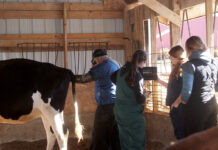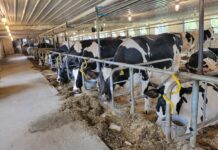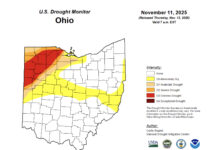The USDA has issued it’s latest forecast for milk, corn and soybean meal prices for the incoming year. Respected economists are behind these forecasts, using some of the best-known tools in econometric forecasting. So what is the picture looking like for 2011?
The USDA is forecasting an average corn price of $4.80 to $5.60/bu for the 2010/2011 crop year and soybean meal price averaging $310 to $350/ton. One would think that with such a wide range in it’s forecast the USDA should be hitting the target even if it never hit the bull’s eye.
On the feed side the USDA price forecasts are generally not bad this time of the year This year, however, the forecast is very ‘iffy’ because the world’s grain and oilseed reserves should be alarmingly low just before the next harvest in the northern hemisphere.
If anything goes bad in the South American crops in the next few months or the North American crops starting next spring and throughout the growing season, then brace yourself for feed prices that could make prior price peaks look low.
In short, the likelihood for a drop in feed prices in the next eight months is low, while the likelihood for an additional surge is significant.
Dairy products
What about milk prices? Currently, international prices are still above U.S. domestic prices for many dairy products. That is very good news, considering that we will have exported more than 16 percent of our milk production on a solids equivalent basis in 2010.
Like it or not, our domestic prices are now intimately linked to world’s prices. The USDA is forecasting a 1.4 percent increase in milk production, reaching 195.5 billion pounds in 2011. The problem, of course, is that milk prices are now very sensitive to slight changes in the balance between supply and demand.
You remember playing on a teeter-totter when you were kids? One kid only had to move a few inches at one end of the plank to make the whole thing go from a perfect balance to a complete tilt. The same thing has happened to our milk pricing, which makes price forecasting very difficult.
For what is it worth, the USDA is forecasting the class III price at $14.45 to $15.25/cwt in 2011, which would be up from the $14.40/cwt in 2010. The class IV price is forecast at $14.50 to $15.40, which would be about even with the $15.10 average for 2010. The all-milk price is forecasted at $15.90 to $16.70, virtually unchanged from the $16.30 average in 2010.
Outlook
The remaining question is how much should you rejoice over these forecasted prices? In my opinion, very little; here’s why.
First, the increase in feed costs that occurred in the last third of 2010 has eaten up the net margins per cwt of milk produced that we had painfully reached in the middle of the year. After a devastating 2009, the very short term — just a few months — of positive returns have not brought back our dairy farms into a good financial situation.
In other words, the average dairy farm will be operating at break-even if the USDA forecasts are accurate. I don’t know about you, but I don’t find operating at break-even something to rejoice over. More importantly, however, is the proverbial inaccuracy of the USDA forecast for milk price.
Incorrect
The USDA December forecast missed the actual milk price by more than $1/cwt in eight of the last 10 years. An old gypsy woman with a broken crystal ball can probably do better than that, or maybe not.
The point is that the USDA milk price forecasts are just not very good for anything exceeding three months in the future. Based on current dairy product prices, we can expect a class III price of about $13.70/ cwt and a class IV price of about $15.15/cwt for December, resulting in a class I price of $16 to $16.50.
Stable
Dairy product prices have somewhat stabilized at $1.60-$1.70 per pound for butter and $1.30-$1.40 per pound for cheese. Currently, we expect milk prices to stabilize at the December levels for the first few months of 2011. After that, it is anyone’s guess.
Financial planning in these times of great uncertainty becomes a nightmare. I advise dairy producers to plan for a storm, but to be prepared and alert in case the ‘weather’ turns up better than expected.
(The author is an Extension dairy specialist at Ohio State University. Questions or comments can be sent in care of Farm and Dairy, P.O. Box 38, Salem, OH 44460.)












